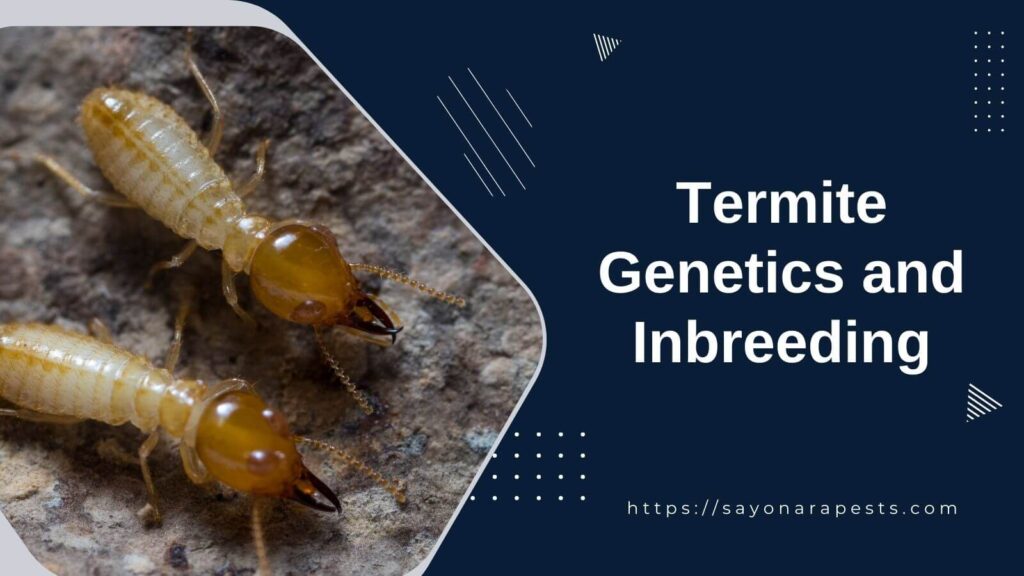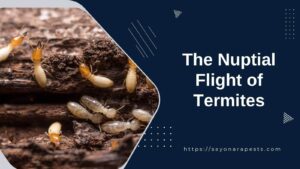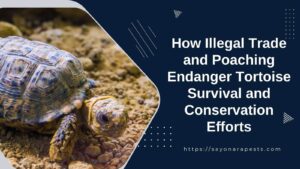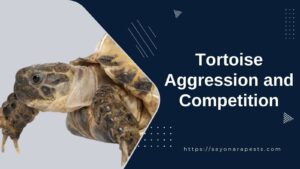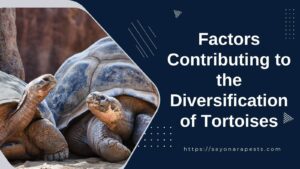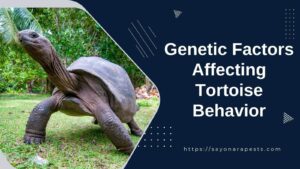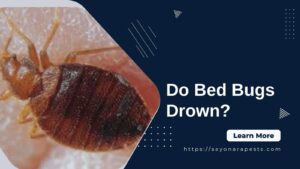In the complicated world of termite colonies, there is a fascinating world hidden beneath the surface of the earth that is ruled by the mysterious forces of termite genetics.
These tiny insects are often overlooked in the big picture of nature, but their genes are very complicated and hold the key to understanding how colonies change over time.
By figuring out the secrets hidden in their DNA, researchers are able to enter a world of unmatched complexity and learn more about how termite societies work.
Termite genetics is the study of genetic information and patterns of inheritance in groups of termites.
At the heart of this scientific pursuit is the complex web of DNA, which is the blueprint of life and controls how these social insects look and act.
Termites have a lot of genes that control how they build huge underground colonies, divide up the work, and communicate, all of which are important for their survival and growth.
Untangling the complicated details of termite genetics reveals a tapestry of genes and regulatory elements that shape the amazing variety of termite species and their complex social structures.
Understanding the genetics of termites is the most important thing to do if you want to understand how colony succession works. In a termite colony, there are different castes, and each caste has its own role and area of expertise.
From the fertile kings and queens to the sterile workers and soldiers, genetic factors carefully plan how the work is split up in these societies.
By learning about termite genetics, scientists can figure out how colonies change from one stage to the next, passing on the responsibility of reproduction and making sure that their lineage continues.
Scientists learn a lot about how ecological dynamics and evolutionary processes shape termite communities when they understand how colony succession is based on genes.
In the field of termite genetics, the long shadow of inbreeding looms over the complex web of life. Inbreeding happens when people in a colony marry close relatives. This makes it more likely that they share the same genetic material.
Termite colonies tend to have some inbreeding because of their unique social structure and limited mating opportunities. However, too much inbreeding can be harmful.
Inbreeding depression is a thing that happens to many organisms. It shows up as less fitness, less resistance to diseases, and slower growth and survival of the colony.
Understanding the effects of inbreeding on termite colonies is important for managing and preserving their genetic diversity and making sure that these ecologically important insects are resilient and able to adapt.
The goal of this article is to explain the fascinating world of termite genetics and show how important it is to understand the complicated dynamics of colony succession.
By digging deep into termite genomes, scientists find a treasure trove of information that helps them figure out how their complex social structures, reproductive strategies, and evolutionary adaptations work.
This article also wants to look into the effects of inbreeding on termite colonies and show how important it is to manage genetic diversity to ensure the long-term survival of these amazing insects and their ability to do their job in the ecosystem.
In the end, the things we’ve learned from studying termite genetics have helped us see the beauty of nature and how we’re all connected, even to the smallest creatures on Earth.
Termite Genetics
Genetics is a complicated field of study that looks at how traits are passed down and how they change in living things.
It looks at how genetic information is passed on from one generation to the next at the molecular level.
When it comes to termites, genetics is a big part of what makes them who they are and how they act.
Their genes have a lot to do with how they look. Termites’ body size, color, and the way their legs and antennae are built are all affected by their genes.
These genetic factors also affect how the body’s internal systems, like the digestive system and nervous system, grow and work.
When researchers look at the anatomy and genetics of termites together, they can learn a lot about the molecular basis of termite biology.
The termite genome is the total amount of genetic material in a termite’s cells. This genome has all the genes that tell a termite how to build and take care of its body, as well as how to carry out its biological functions.
DNA, a long molecule that stores and sends genetic information, is what makes up the termite genome.
Scientists have been able to figure out the termite genome by using advanced sequencing techniques. This has given them a lot of information about the genetic structure of these social insects.
Termites that reproduce and termites that don’t reproduce have different genetic traits. Termites that can reproduce have the genes needed to make eggs and sperm and other parts of the genetic machinery needed for reproduction.
On the other hand, termites that don’t reproduce, like workers and soldiers, have genetic traits that help them do their jobs in the termite colony.
These differences in genetics help termites decide who does what work and who belongs in which caste.
People in the field are very interested in how genes affect which caste a termite is in. Caste determination is the process by which termites become different kinds of termites, like workers, soldiers, and reproducers.
Genetic factors, such as how genes are expressed and how they are controlled, are thought to be very important in this process.
Researchers have found specific genes and molecular pathways that determine a termite’s caste. This shows how complex the genetic interactions are that make up a termite’s social structure.
Genetic variation in termite colonies is a very interesting subject to study. Even though termite colonies are very cooperative, they have a surprising amount of genetic diversity.
This genetic variation can happen in a number of ways, such as through sexual reproduction, recombination of genes, and genetic mutations. It is a very important part of how termite colonies adapt and stay strong when the environment changes.
Understanding the genetic diversity of termite populations gives us important information about how they have changed over time and how they interact with their environment.
Genetic markers are very helpful tools that researchers use to find and track specific genetic traits in termites. These markers are pieces of DNA that are different in different people or groups.
Scientists can find out how related termites are, find out where they came from, and look into patterns of gene flow and exchange by looking at genetic markers.
Genetic markers have helped us learn a lot about the genetics of termite populations, their phylogeny, and how invasive termite species spread.
Genomic studies have helped us learn a lot about how termites are genetically made. Researchers have found key genes that are linked to different termite traits and behaviors by looking at the whole genome.
These studies have shown how termites have changed over time, like how they can eat wood and use chemical signals to talk to each other.
Also, genomic studies have shown how different termite species are related to each other in terms of evolution and shed light on the genetic processes that drive termite diversity.
Epigenetic factors are very important in determining how termites behave and which caste they belong to. Epigenetics is the study of changes in gene expression that are passed down but don’t involve changes in the DNA sequence.
Epigenetic changes, such as the methylation of DNA and changes to histones, can control the activity of genes that are involved in determining a termite’s caste and in other behaviors.
Understanding how genetics and epigenetics work together gives a more complete picture of the factors that shape termite social systems and could lead to new ways to control termite behavior for pest control.
The study of termite genetics gives us a fascinating look at the complex molecular processes that control termites’ biology, behavior, and social structure.
Through studying the termite genome, finding genetic markers, and combining epigenetic research, scientists are learning about the hidden complexity of termite genetics and what it means for termite colonies, and how they interact with their environment.
Inbreeding in Termite Colonies
Inbreeding is a very important thing that happens in the complicated world of termite colonies. Inbreeding in termite colonies, which is defined as the mating of people who share a close genetic relationship, has caught the attention of both researchers and entomologists.
This phenomenon affects a lot more than just genetic diversity. It affects a lot of things that make up the complex web of life in these tiny worlds, called microcosms.
There are many different things that can lead to inbreeding in termite colonies. Inbreeding is often caused by a lack of ability to move around, few chances to mate, and the isolation of the colony as a whole.
Also, the genetic structure of termite colonies, which often has a small effective population size and a high degree of relatedness between individuals, makes it easy for inbreeding to happen.
When termite colonies breed among themselves, the effects are far-reaching and important. First of all, inbreeding leads to less genetic diversity, which makes it harder for these communities to adapt and change.
When termite colonies have less genetic material to work with, they are more likely to face the dangers of genetic disorders.
People who are inbred have a higher chance of inheriting harmful recessive alleles, which makes them more likely to get sick and hurt their overall health and fitness.
Also, when termite colonies breed, it makes them less able to deal with environmental stresses. Because of inbreeding, there is less genetic diversity, which leads to less phenotypic plasticity.
This makes it harder for colonies to adapt and respond to changes in their environment. Because of this, they become more sensitive to changes in temperature, humidity, and the availability of resources, which makes it harder for them to stay alive.
Inbreeding in termite colonies has a big effect on their ability to have children, which is a key part of a healthy community. Inbred individuals have less fertility and fewer offspring, which slows down the growth and spread of the colony.
As a result, the long-term health and sustainability of the population are threatened because inbred people are less likely to have children.
Surprisingly, termites have found ways to avoid the dangers of inbreeding. These ways to avoid getting caught show how complicated the social relationships are in the colony.
First, inbred individuals self-remove themselves when they realize they are genetically inferior and give up their ability to reproduce for the greater good of the colony.
Inbreeding is also less likely because queens are picky about who they mate with and choose partners who are genetically different from themselves.
Also, the way sperm is used, like selective sperm precedence, helps keep termite colonies from getting too close to each other.
But even though these things are in place, termite colonies can still show signs of the problem of inbreeding depression. Inbreeding depression is when a colony’s fitness and performance as a whole go down because its members are related.
This bad effect shows up in many ways, like fewer animals making it to adulthood, slower growth and development, and less efficient hunting. Termite colonies can be less stable and live less long because of the bad effects of inbreeding depression.
There are a lot of differences in how often and where inbreeding happens in different termite species. Some termite species have a lot of inbreeding, while others prefer to breed with other species.
These differences are caused by things that are unique to each species, like how they move around, how they mate, and how their genes are organized.
By looking at these differences, we can learn more about how evolution works and how inbreeding affects termite communities as a whole from an ecological point of view.
In the complex way that termite societies are put together, social behavior plays a key role in reducing the bad effects of inbreeding.
Termite colonies create an environment that helps genetic diversity and lessens the effects of inbreeding by encouraging cooperative and selfless behavior.
Cooperation and division of labor within the colony make sure that resources are used and shared in the best way possible, making up for any problems caused by inbreeding.
Inbreeding in termite colonies is a fascinating process that has many facets. It has big effects on genetic diversity, colony strength, and the success of reproduction.
Still, termites have developed complex ways to avoid the bad effects of inbreeding, and their social behavior is one of the most important tools they use to do this.
Understanding how inbreeding works in termite colonies can teach us a lot about the delicate balance of nature and the amazing adaptations that make these termites what they are.
Implications for Colony Succession
Colony succession is a complicated process of ecological change that happens in termite populations. It is the most important thing that affects the long-term survival and success of these social insects.
It has to do with how termite colonies change from one generation to the next. This has big effects on their genes, behavior, and overall health.
When you think about how genetic diversity, inbreeding, and the ability of colonies to adapt and thrive in changing environments all work together, you can see how complicated colony succession is.
In termite populations, genetic diversity is one of the most important parts of how colonies grow and change over time.
High genetic diversity means that the termite colonies have more genetic material, which gives them a wider range of adaptive traits to choose from.
This diversity acts as a defense against environmental problems, making it more likely that the species will survive and keep going for generations.
In a way, genetic diversity is like an insurance policy. It gives termite colonies the genetic resources they need to face and deal with new challenges that may come up during the process of colony succession.
On the other hand, the risks of inbreeding make the chances of colony succession look bad. Inbreeding happens when genetically related termites in a colony mate. This has a lot of bad effects.
First of all, inbreeding raises the risk of colony collapse because the accumulation of bad recessive traits can hurt the health and viability of the colony.
Second, inbred colonies are less able to adapt to changing environments because they don’t have enough genetic variation to quickly respond and adjust to new situations.
Because they don’t have much genetic variation, they can’t develop or adopt traits that would help them. This makes them vulnerable to changes in their environment.
Inbreeding also makes competition between termite colonies worse. As genetically related people breed, the already small gene pool gets even smaller. This makes it harder to get resources and makes it harder for people to get along with each other.
This increased competition not only makes it harder for everyone in the colony to get along and work together but also slows down their overall productivity.
Conflicts caused by inbreeding make it harder for the colony to work together to get resources and grow. This makes it harder for the next generation to take over the colony.
Still, there are some examples of successful colony succession in termite populations with a lot of genetic diversity. These examples show how important genetic diversity is in determining how termite colonies grow and change over time.
By keeping their genetic makeup diverse, these populations are better able to deal with environmental challenges, adapt, and stay alive.
The genetic diversity gives these colonies a strong base on which to build their success, allowing them to keep coming up with new ideas and thrive in changing environments.
But genetic bottlenecks can make it very hard for a colony to pass on its genes. These bottlenecks happen when the genetic diversity of a termite population drops by a lot. This is often caused by disasters or other big changes.
Such things can severely reduce the amount of genetic variation, making it harder for termite colonies to change during succession.
The reduced genetic diversity makes it harder for the colony to adapt to changes in the environment. This makes it harder for them to start new colonies and spread out.
Termite populations have more genetic diversity because of a number of factors. Heterogeneity in the environment is a key factor in making different niches and habitats, which are important for differentiation and speciation.
Termites’ movement patterns, like dispersal and migration, make it easier for genes to move between colonies. This means that genetic material can be shared and that diversity can be kept.
Also, mating between people from different colonies, which is called “outbreeding,” adds a lot to genetic diversity by adding new genetic material to the gene pool.
The way these factors work together promotes genetic diversity and sets the stage for successful colony succession.
In the end, genetic diversity has a direct effect on how resilient termite colonies are during colony succession.
Colonies with a lot of genetic diversity have a wider range of traits that help them adapt, which makes them better able to deal with environmental changes and challenges.
The more genetic diversity there is, the more likely it is that colonies will be able to follow the complicated path of succession. Inbreeding, on the other hand, makes it harder for termite colonies to grow and start new colonies.
Their ability to adapt is limited because they have less genetic variation. This makes them less resilient and hurts their long-term survival.
When it comes to termite populations, colony succession is a complex interaction between genetic diversity, inbreeding, and the ability to adapt and start new colonies.
Genetic diversity is a key success factor because it gives colonies the genetic resources they need to face and overcome environmental challenges.
On the other hand, inbreeding is dangerous because it can lead to colony collapse, less ability to adapt, more competition, and less productivity.
Understanding the effects of genetic diversity and inbreeding on colony succession gives us important information about what makes termite colonies strong and able to live for a long time.
In conclusion, studying termite genetics and inbreeding is a fascinating and complicated field of study that has far-reaching effects on how to get rid of termites and how colonies change over time.
Scientists have learned a lot about the social structure and behavior of termite colonies by studying different genetic traits, such as patterns of inbreeding and genetic diversity.
This information has helped us understand how termite societies work, which has led to the creation of better ways to get rid of them.
For successful termite control, it is very important to understand the genetics and inbreeding of termites.
Researchers have learned a lot about how beneficial traits, susceptibility to diseases, and resistance to control methods are passed down in termite colonies by studying their genes.
With this information, pest control professionals can come up with targeted and effective ways to stop termite infestations and limit the damage they do to buildings.
Also, if experts understand how inbreeding works in termite populations, they can adjust their control methods to deal with the unique problems that come up in inbred colonies.
Even though the field of termite genetics and inbreeding has made a lot of progress, there are still some questions that need to be answered. Exploring how the environment affects the genes of termites is an important area for future research.
Understanding how environmental conditions affect genetic diversity, mating patterns, and rates of inbreeding can tell us a lot about how well termite colonies can adapt.
Also, studying how genetic and epigenetic factors interact in how termites behave and decide which caste they belong to could help figure out the complex mechanisms that makeup colony organization.
There are many uses for knowing about the genetics and inbreeding of termites.
With information about the genetic makeup of termite colonies, pest control experts can come up with targeted control plans that take advantage of weaknesses that are unique to certain genetic profiles.
For example, finding colonies with low genetic diversity or high inbreeding coefficients could show that they are more likely to be affected by control measures.
Also, knowing how genes affect certain behaviors, like looking for food or building a nest, can help come up with new ways to stop these important things from happening.
Studying the genetics and inbreeding of termites is hard and has some limits. The fact that termite colonies are hard to figure out is a big problem.
Their underground lives and complicated social structures make it hard to get samples and do genetic analyses.
Also, it can be hard to figure out exactly how genetically related people in a colony are to each other because of things like multiple reproductive individuals and secretive ways of reproducing.
Also, there aren’t that many termite genome sequences, which makes it hard to do complete genetic studies and compare different species.
Future research should focus on interdisciplinary approaches and teamwork to help us learn more about termite genetics and what it means for how colonies change over time.
By combining ecological and behavioral studies with advanced genetic techniques like high-throughput sequencing and genotyping, we can learn more about how genetics, behavior, and colony dynamics all work together in a complex way.
Also, making genetic research about a wider range of termite species will make it possible to do comparisons and shed light on the general rules that govern termite genetics.
Lastly, setting up long-term monitoring programs to track how termite populations and genetic diversity change over time would give us important information about how colonies change over time and how they adapt to changes in the environment.
In a nutshell, the study of termite genes and inbreeding is very important for controlling termites and passing on colonies.
By figuring out how termite societies are put together genetically, researchers can come up with targeted ways to control them, take advantage of weaknesses, and come up with new ways to stop termite infestations.
Even though there are problems and limits, interdisciplinary approaches and collaborative research can help us learn more about the genetics of termites and what that means for the long-term management of these amazing social insects.

